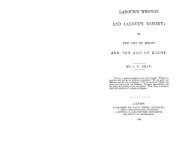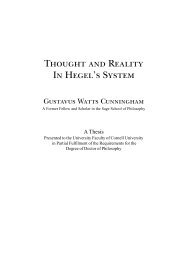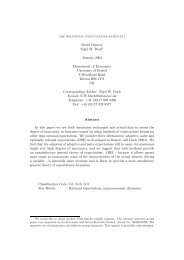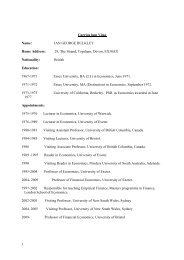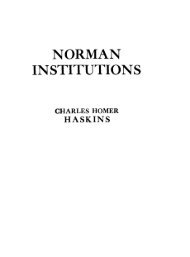Bivariate or joint probability distributions
Bivariate or joint probability distributions
Bivariate or joint probability distributions
You also want an ePaper? Increase the reach of your titles
YUMPU automatically turns print PDFs into web optimized ePapers that Google loves.
3.13 Expectations and variances<br />
8<br />
Discrete random variables<br />
r<br />
r<br />
r<br />
r<br />
( ) = ∑ ∑ ( , ) = ∑ x ∑ p( x , y)<br />
= x p<br />
X ( x)<br />
E X x p x y<br />
x<br />
y<br />
x<br />
r<br />
r<br />
r<br />
r<br />
( ) = ∑ ∑ ( , ) = ∑ y ∑ p( x , y)<br />
= y pY<br />
( y)<br />
E Y y p x y<br />
Examples<br />
x<br />
y<br />
y<br />
y<br />
x<br />
∑ r =1,2.....<br />
x<br />
∑ r =1,2....<br />
y<br />
2 2<br />
Hence Var(X) = E( X ) − ( E( X ))<br />
, Var(Y) = E( Y ) ( E( Y<br />
)<br />
Continuous random variables<br />
∞<br />
∞<br />
r r r<br />
( ) ∫ ∫ ( ) ∫ X ( )<br />
− etc.<br />
2 2<br />
E X = x f x , y dx dy = x f x dx r = 1, 2 .....<br />
−∞ −∞<br />
∞<br />
∞<br />
r r r<br />
( ) ∫ ∫ ( ) ∫ Y ( )<br />
E Y = y f x , y dx dy = y f y dy r = 1, 2 .....<br />
Examples<br />
−∞ −∞<br />
∞<br />
−∞<br />
∞<br />
−∞<br />
3.14 Expectation of a function of the r.v.'s X and Y<br />
Continuous X and Y<br />
Discrete X and Y<br />
∞<br />
∞<br />
∫ ∫<br />
E[ g( X, Y)] = g( x, y) f ( x, y)<br />
dxdy<br />
−∞ −∞<br />
∞<br />
∞<br />
e . g . ⎡<br />
E X ⎤ x<br />
⎣<br />
⎢ Y ⎦<br />
⎥ = ∫ ∫<br />
y f ( x, y)<br />
dxdy<br />
E[XY] =<br />
−∞ −∞<br />
∞<br />
∞<br />
∫ ∫<br />
−∞ −∞<br />
xy f ( x , y ) dxdy .<br />
3.15 Covariance and c<strong>or</strong>relation<br />
Covariance of X and Y is defined as follows : Cov (X,Y) = σ XY<br />
= E(XY) - E(X)E(Y).<br />
Notes<br />
(a) If the random variables increase together <strong>or</strong> decrease together, then the covariance<br />
will be positive, whereas if one random variable increases and the other variable<br />
decreases and vice-versa, then the covariance will be negative.<br />
(b) If X and Y are independent r.v's, then E(XY) = E(X)E(Y) so cov(X, Y) = 0.<br />
However<br />
if cov(X,Y) = 0, it does not follow that X and Y are independent unless X and Y are



